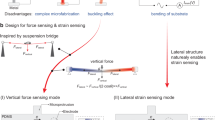Abstract
A novel micro force-torque sensor with tuning mechanism is presented in this paper. The sensor is designed and fabricated based on monolithic integrated method, including planar graphic manufacturing and lamination process. The sensing element is composed of cross-shaped double cantilever beams which will deform when loading force and Torque. The process of sensor is divided into two parts. The structure-circuit integration process is proposed to realize the planar structure of sensor, which integrates flexible printed circuit (FPC) in the graphic multi-layer materials. The assembly of force-torque sensor is realized by the design of foldable mirror structure with each component connected by flexible limited hinges, which can form and lock at 90°. By bring in piezoelectric (PZT) composite cantilever beams as tuning mechanism, the position of the sensor can be further tuned, so that the system precision can be significant improved. According to the result of calibration and experiments, the sensor prototype has a force sensitivity of 0.29 μm/mN, a torque sensitivity of 0.33 μm/μNm and a bandwidth of 481.44 Hz, the range of force and torque measurement is – 7~7 mN and – 14~14 μNm respectively. And the linear-adjustment sensitivity of PZT composite cantilever beam is 24.69 nm/V.







Similar content being viewed by others
References
Beyeler F, Muntwyler S, Nelson BJ (2009) A six-axis MEMS force-torque sensor with micro-newton and nano-newtonmeter resolution. J Microelectromech Syst 18(2):433–441
Beyeler F, Muntwyler S, Zoltán N, et al (2007) A multi-axis MEMS force-torque sensor for measuring the load on a microrobot actuated by magnetic fields. In: 2007 IEEE/RSJ international conference on intelligent robots and systems, October 29–November 2, 2007, Sheraton Hotel and Marina, San Diego, California, USA IEEE, 2007
Dargent T et al (2009) Micromachining of an SU-8 flapping-wing flying micro-electro-mechanical system. J Micromech Micro Eng 19(8):085028
Hida H, Morita Y, Kurokawa F et al (1436x) Simple millimeter-scale robot using Pb (Zr, Ti) piezoelectric thin film actuator on titanium substrate. Microsyst Technol 22:1429–1436x
Leea JS, Kimb DK, Lee JM (2008) Experimental evaluation of a flapping-wing aerodynamic model for MAV applications. In: SPIE active and passive smart structures and integrated systems, vol 3
Ma, KY, Felton SM, Wood RJ (2012) Design, fabrication, and modeling of the split actuator microrobotic bee. In: IEEE/RSJ international conference on intelligent robots and systems IEEE
Mazaheri K, Ebrahimi A (2010) Experimental investigation of the effect of chordwise flexibility on the aerodynamics of flapping wings in hovering flight. J Fluids Struct 26:544–558
Phan HV, Park HC (2016) Generation of control moments in an insect-like tailless flapping-wing micro air vehicle by changing the stroke-plane angle. J Bionic Eng 13(3):449–457
Sreetharan PS, Whitney JP, Strauss MD et al (2012) Monolithic fabrication of millimeter-scale machines. J Micromech Microeng 22(5):055027
Wood RJ, Cho KJ, Hoffman K (2009) A novel multi-axis force sensor for micro robotics applications. Smart Mater Struct 18(12):125002
Zhou S, Zhang W, Zou Y, Ke X, Cui F, Liu W (2017) Piezoelectric driven insect-inspired robot with flapping wings capable of skating on the water. Electron Lett 53(9):579–580
Zhou S, Zhang W, Zou Y, Ou B, Xun Z (2018) Piezoelectric-driven miniature wheeled robot based on flexible transmission mechanisms. Microsyst Technol 24(2):943–950
Zou Y, Zhang W, Zhang Z (2016) Liftoff of an electromagnetically driven insect-inspired flapping-wing robot. IEEE Trans Rob 32(5):1285–1289
Zou Y, Zhang W, Zhou S, Ke X, Cui F, Liu W (2018) Monolithic fabrication of an insect-scale self-lifting flapping-wing robot. Micro Nano Lett 13(2):267–269
Acknowledgements
This research is supported by the Supporting Foundation of the Ministry of Education (6141A02022607, 6141A02022627), the Pre-research Fund (1816311ZT005020, 301020803, 17070107), Shanghai Science and Technology Commission Project (19511104202), and Shanghai Professional technical service platform (19DZ2291103).
Author information
Authors and Affiliations
Corresponding author
Additional information
Publisher's Note
Springer Nature remains neutral with regard to jurisdictional claims in published maps and institutional affiliations.
Rights and permissions
About this article
Cite this article
Meng, R., Zhang, W., Zhou, S. et al. A micro monolithic integrated force-torque sensor with piezoelectric tuning mechanism. Microsyst Technol 26, 2879–2886 (2020). https://doi.org/10.1007/s00542-020-04829-2
Received:
Accepted:
Published:
Issue Date:
DOI: https://doi.org/10.1007/s00542-020-04829-2




